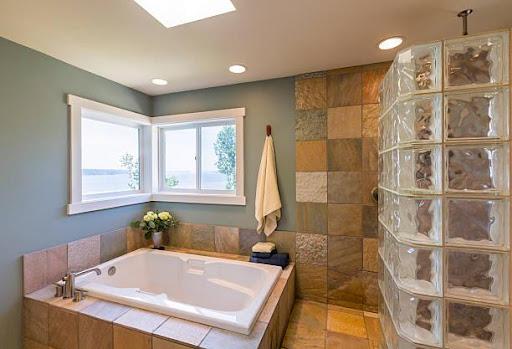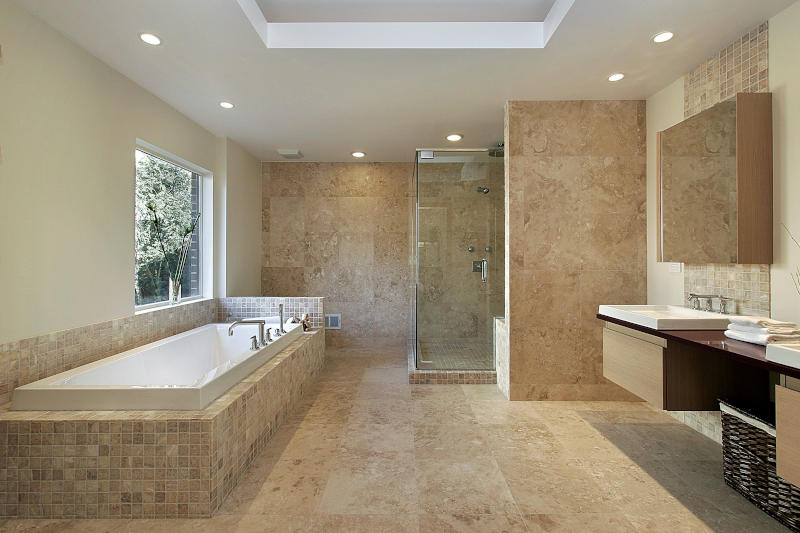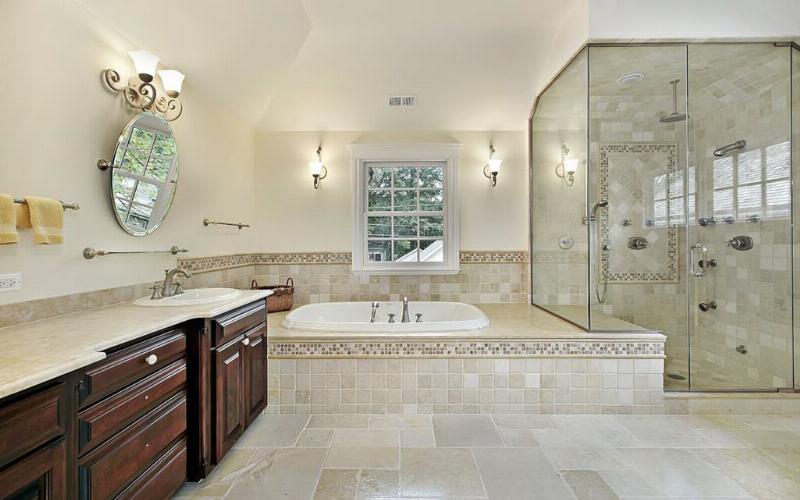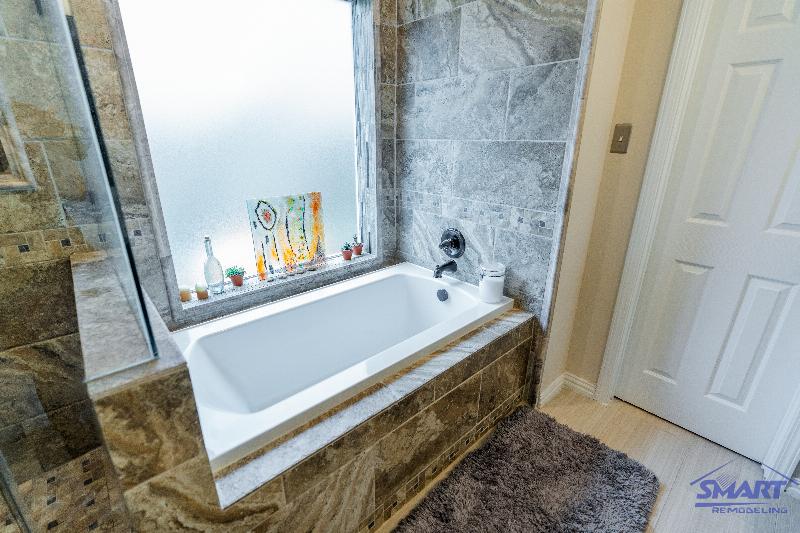Tub surrounds over tile are the most cost-effective and simplest method to update your bathroom. Tub surrounds are your best bet if you’re tired of the dull tiled wall around your tub and want to replace it without much mess or cost.
These don’t require expert installation and can be installed directly over existing tiles. Doing it this way eliminates the need to remove and retile the bathroom walls.
How to Decide on Tile Surround For Your Bathroom

Surrounds shopping is straightforward because panel thickness affects both quality and pricing. ABS or PVC plastic panels that are too thin to stand against a wall without extra support are available at the low end.
The mid-price range consists of thermal-plastic units with molded features and looks. These are usually more elegant and well-made.
The most durable of them all is the pressed-fiberglass kits. They have thick and practically solid panels that are extremely durable.
All of these kits resist water well and are easy to install. They are also attractive and easy maintenance making them the most suitable choice for tub surround installation. The more fragile the material, the more difficult it is to install. Thin panels may require wooden bracing while the glue sets and they might reflect adhesive beads and wall defects. (This Old House, 2021)
How to Install a Tub Surround Over Tiles
Bathroom tiles often stay a long time with proper care and maintenance. If they aren’t properly cared for, they may fracture and grow mold, causing their removal and replacement. The good news is that you may speed up your bathroom renovation by replacing your outdated shower tiles with a tub surround. This is how to install a tub surround over tiles.
You will need the following tools and materials:
Tools | Materials |
|---|---|
Pry Bar | Adhesive |
High-Grit Palm Sandpaper | Bathtub or Shower Surrounds |
Screwdriver | Caulk |
Open-End Wrench | |
Hacksaw | |
4-Foot Level | |
Straightedge | |
Belt Sander | |
Utility Knife | |
Jigsaw |
Step 1: Choose the Tub Surround
There are large selections of tub surrounds from which to pick. They come in a variety of styles to match your furnishings and give your bathroom a new look. You will have to make a decision between acrylic and fiberglass surrounds. Regardless of the option you choose, you will benefit from both. Acrylic and fiberglass are low-maintenance materials that will last long in your bathroom. They do not need any heavy-duty scrubbing and cleaning, unlike old tiles. You can choose any color and shade for the tub surround to compliment the bathroom’s color scheme. (Do It Yourself, 2021)
ProTip Takeaway: The texture of the tub surrounds is divided into three categories: smooth, rough, and slightly pebbled. Make a decision based on your preferences.
Step 2: Remove the plumbing fixtures
Remove the showerhead, faucet handle, spout, and faceplate. Screws are usually used to hold each of these objects in place. Remove the items from the shower wall by unscrewing the screws using a screwdriver. You’ll also need to remove your shower head if it’s in the tiled area. Simply use an open-end wrench to hold the head’s wrench surfaces and back out the showerhead, arm, and flange. To protect the tub’s surface while you work, place a drop cloth in it.
ProTip Takeaway: When removing plumbing fixtures, don’t use too much force. Simply turn the handles and pull them out in a counterclockwise motion. Check to see if the pipe inside the wall has cracked. Also, keep the dress-up shower rings in a safe place.
Step 3: Rough Up the Surface of the Tile
To roughen up the surface of the tile, scratch it with sandpaper. It’s recommended to sand the tile surface with high-grit palm sandpaper. This improves the adhesion of the tub surrounding the sealant. You may notice some loose tiles when you sand them. Yank them out using a pry bar. Apply tile glue to the backsides of any loose tiles before reinstalling them.
ProTip Takeaway: The tiles must be properly de-glossed before the surrounds can be installed; otherwise, the surround will not be firm.
Step 4: Cleaning the bathtub area
Clean the bathtub and the area around it. To do this properly, dampen a clean cloth with a liquid soap solution combined with warm water. Wipe the tub and tiled walls well with the wet towel and allow the area to dry.
Step 5: Cut and install Apron-Trim pieces together
The first thing you need to do is to measure the height of the tub from the top edge of the baseboard molding to the top border of the tub. Then transfer this measurement to the available apron-trim piece. Cut it to length with a hacksaw. Measure the width of the tub, then transfer those measurements to another supplied apron-trim piece and hacksaw it. Remove the paper backing from the apron-trim pieces and fix one to the wall next to the tub. Stick the piece to the tile over the tub.
Step 6: Align the Vertical Apron-Trim Piece
Hold a 4-foot level against the tub’s vertical apron-trim piece. Make sure the level is plumb. Then using the level as a straightedge, draw a pencil line on the wall.
Step 7: Attach the Back Panel
Install the back panel of the tub surround first. Lift it up to the wall, aligning its outside edge with the pencil line you drew in Step 4. Be sure to position it so that it is plumb. If required, use a belt sander to file some of the panel’s bottom edge off.
ProTip Takeaway: Filing ensures it fits plumb against the wall and there are no major gaps between the tub’s top edge and the panel’s bottom edge.

Step 8: Apply the sealant and place the panel in place
Flip the panel over and place the provided sealant tube in a caulk gun. Then apply a bead of sealant along the perimeter of the panel, about 1 inch in from the foam tape. Position the panel over the tile by peeling the paper backing off the foam tape on the back of the panel. Rub your palm up and down the panel to firmly press it against the tile. (Lowes, 2021)
Step 9: Place Side Panel
Test-fit the side panel of the shower and sand away a portion of the bottom edge if required. Next, measure the length of the wall and then divide it into two. Be sure to make a mark on the tiles at this spot with a marker. Also, measure the length of the panel and divide it by two. At this point, make a mark on the panel. Repeat Step 6 to install the panel on the tiles, aligning the two center points.
Step 10: Make a Cardboard Template
Cut a piece of cardboard to match the size of the front panel. This will be the starting point for all of the fixtures. Measure each fixture’s location on the wall and write down the measurements on the cardboard. Cut each hole with a utility knife. Then check your measurements by holding the cardboard template up to the tile shower wall.
Step 11: Trace the cutouts from the template onto the panel
Cover the front panel with the cardboard template. Using the circular cuts as a guide, trace the cutouts onto the panel. Use a jigsaw and a 1-inch bit to cut off the tracings. Double-check that the cutouts align with the fixture positions.
Step 12: Apply Panel Sealant
Apply sealant beads to the back of the panel and around each cutout with the provided sealant. Place the panel on the tiles and press it down.
Step 13: Replace the fixtures and re-seal the area
Replace the faceplate, faucet, spout, and showerhead. Apply a bead of silicone caulk to the corner and bottom seams where the panels meet. Do the same for the top edge of the tub. Then, use a wet finger to smoothen the caulk. (Hunker, 2021)
ProTip Takeaway: Thinset mortar and epoxy mortar are the ideal tile adhesives for high-moisture areas like showers. Professionals use epoxy mortar or standard powder thin-set, whereas do-it-yourselfers use premixed thin-set mortar.
How Much Does It Cost to Install a Tub Surround?
A properly constructed solid-surface project can cost anywhere from $1100 to $2000. Standard tile installation costs between $600 and $1000. Plastic tub surround kits range in price from $60 to $500, with the most common kits costing approximately $150. This plastic tub surrounds include pressed fiberglass.
Bathtub liners range in price from $850 to $1,400 for the liner alone. For installation, you can expect to pay between $1,600 and $3,000 with most homes spending an average of between $1,700 and $2,500.

Bathtub Liners are available in a variety of colors and styles. $2,000 is the national average cost. $1,600 is the minimum cost. The maximum cost is $3,200, with an average cost of $1,700 to $2,500. (Popular Mechanics, 2021)
ProTip Takeaway: Tub surround kits are quite popular and there are a variety of options to choose from. These include new tile, plastic tub surround kits, and professionally placed solid-surface panels.
Are You Ready To to Install a Tub Surround
The work that goes into installing a tub surround over tile is quite a lot. If you are up for the task you can do it on your own. It is advisable to also get an experienced professional to do it for you.
Smart Remodeling LLC is here for you and all your bathroom remodeling needs. Our professionals will work on your bathroom to give you the best results. Feel free to call us today for a free consultation.






